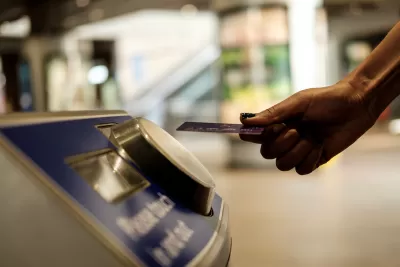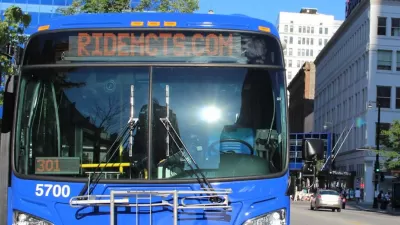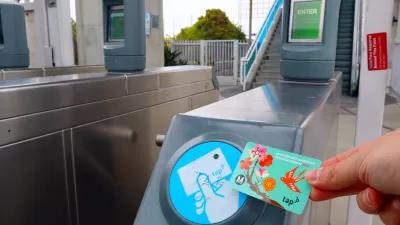Cashless fare options let agencies enable fare capping, track rider behavior, and eliminate proprietary fare cards.

In an article for GovTech, Skip Descant describes how cashless fare payment technology on public transit is changing the way transit agencies collect fares, enable fare capping, and speed up service.
According to Descant, “Fare-capping is often championed by transportation equity advocates as a way to corral runaway transit costs for low-income riders, since fares are capped at a certain amount for a set duration of time.” Technology now enables fare capping that wasn’t possible with cash payments. “But open loop systems can go beyond fare-capping to provide rich caches of data that officials can use to design incentives, loyalty programs and even routes,” Descant adds.
Newer fare payment systems also offer ‘open loop’ payments, meaning riders can use any debit or credit card to pay rather than a system-specific card. “New developments in areas like digital driver’s licenses could be made interoperable with digital fare payment systems to quickly and accurately validate data like age, disability or veteran status — all of which are often linked to transit discount programs.”
A 2022 study from the University of Oregon revealed a need for a cash payment option, however, noting that many of the people who depend on transit the most are still more likely to be unbanked.
FULL STORY: Tap-To-Pay Transit Tech Is Cash-Poor, but Rich in Data

Alabama: Trump Terminates Settlements for Black Communities Harmed By Raw Sewage
Trump deemed the landmark civil rights agreement “illegal DEI and environmental justice policy.”

Planetizen Federal Action Tracker
A weekly monitor of how Trump’s orders and actions are impacting planners and planning in America.

The 120 Year Old Tiny Home Villages That Sheltered San Francisco’s Earthquake Refugees
More than a century ago, San Francisco mobilized to house thousands of residents displaced by the 1906 earthquake. Could their strategy offer a model for the present?

Ken Jennings Launches Transit Web Series
The Jeopardy champ wants you to ride public transit.

BLM To Rescind Public Lands Rule
The change will downgrade conservation, once again putting federal land at risk for mining and other extractive uses.

Indy Neighborhood Group Builds Temporary Multi-Use Path
Community members, aided in part by funding from the city, repurposed a vehicle lane to create a protected bike and pedestrian path for the summer season.
Urban Design for Planners 1: Software Tools
This six-course series explores essential urban design concepts using open source software and equips planners with the tools they need to participate fully in the urban design process.
Planning for Universal Design
Learn the tools for implementing Universal Design in planning regulations.
Clanton & Associates, Inc.
Jessamine County Fiscal Court
Institute for Housing and Urban Development Studies (IHS)
City of Grandview
Harvard GSD Executive Education
Toledo-Lucas County Plan Commissions
Salt Lake City
NYU Wagner Graduate School of Public Service





























